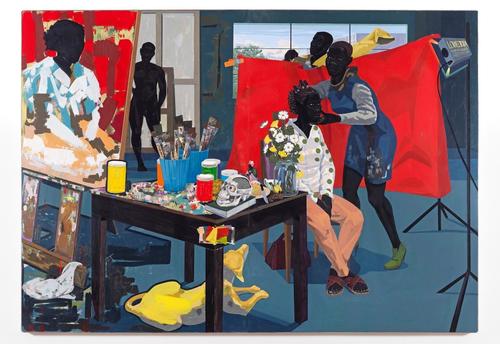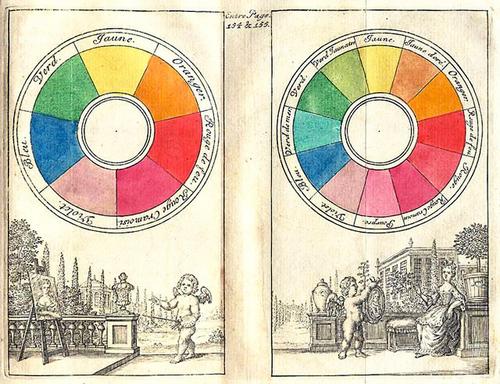 Kerry James Marshall, Untitled (Studio), Metropolitan Museum of Art.
Kerry James Marshall, Untitled (Studio), Metropolitan Museum of Art.
What does Red look like?
Fire truck Red. A bright Red fire truck in a green park, under the blaze of a fire, at sunrise. To describe a color in words, even with great specificity, will still produce a different image to everyone when imagined. The same red will look different depending on light, environment, our eyes, and their communication to our brain. Color is relative. Because it is subjective, color is impossible to explain. Now, with that in mind, let me explain it.
The Science:
Color is inexorably linked to light. Isaac Newton’s work with sunlight and prisms revealed that pure white light consists of all the colors in the light spectrum combined, while black is the absence of light. Different things are different colors because they absorb some wavelengths of the visible spectrum while other wavelengths bounce off. The Red fire truck is absorbing wavelengths of blues, purples, oranges, yellows, greens, etc., while the red is bouncing off and hitting our eyes. That light passes through the rods and cones in our eyes through the nervous system to our brain which then interprets it as color. So essentially, the color we perceive something to be is precisely the color it is not. Ultimately we are left with the question of whether color exists physically or if it is an internal manifestation created by our minds. If you and I were to look at the same Red fire truck, would we see the same Red? Science has not come up with the answer and as such, we, as artists, are better off disregarding the debate all together and instead focusing on how color can be used to inform our own work.
 Charles Boutet, Color Circles from "Traité de la peinture en mignature," 1708.
Charles Boutet, Color Circles from "Traité de la peinture en mignature," 1708.
The Systems:
If you were anything like me, you most likely spent a lot of school recesses debating over ROYGBIV or the ‘rainbow order.’ What is the difference between Blue and Indigo? Is Violet more accurate than Purple? Don’t even get me started on Cyan and Magenta. In an attempt to talk about color in a concrete way, artists have devised different systems of terms, tools, diagrams, and theories. Invented in the 17th century by Newton, the color wheel is a popular way to illustrate the different interactions between colors. The color wheel categorizes colors into different color schemes. Here are the basic color schemes and examples of paintings that utilize them:
Monochromatic – Using only one color and it’s values. Value is the relative darkness or lightness of a color.
- Reisebüro (Travel Agency) by Gerhard Richter
- Tableau Vert by Ellsworth Kelly
- Man in Blue I by Francis Bacon
Primaries – Red, Yellow, and Blue. These cannot be made by mixing other colors together.
Secondaries – Orange, Green, and Purple. These are made by mixing two primaries together.
- Ponds and Streams by Wayne Thiebaud
- Carnation, Lily, Lily, Rose by John Singer Sargent
- Woman with a Hat by Henri Matisse
Analogous – colors that are next to each other on the color wheel. For example, Yellow, Green, and Blue.
- Self-Portrait by Vincent van Gogh
- Morning Glories by Suzuki Kiitsu
- A Young Girl Reading by Jean-Honoré Fragonard
Complementary – colors that are opposite of each other on the color wheel. For example, Red and Green, Blue and Orange, and Yellow and Purple.
- La Berceuse by Vincent van Gogh
- Impression, Sunrise by Claude Monet
- No. 9 (Dark Over Light Earth/Violet and Yellow in Rose) by Mark Rothko
Although it never helped me win the argument on behalf of Purple on the jungle gym, the color wheel can come in really handy if you’re stuck mixing colors and they keep coming out muddy. One of the most important things I’ve learned is that mixing complementary colors together will often make brown. However, placing complimentary colors next to each other will emphasize their vibrancy! Now when I make mud, I mean to make mud.
The History:
The history of pigments informs the history of art. The first pigments we know of were made in the Paleolithic era around 350,000 years ago from grinding up rocks into a fine dust. Before major world trade, pigments were regional, made from what could be found locally. Essentially, this created color schemes for different communities. If you built your home on Red and Yellow dirt, you’d have a Red and Yellow house! Trendy, right? This has been a useful way for archeologists to date objects as well as trace where they’ve traveled. During the Industrial Revolution, many new pigments were invented from the chemical reactions discovered in factories. These new pigments, along with the invention of the paint tube, gave birth to the dazzling color schemes of Impressionism. Today you can buy pigments that reflect, shift color, glow in the dark, and disappear! We continue to innovate. Although modern science has made pigments more readily accessible, the colors maintain their historical significance. This informs what colors mean.
The Cultural:
At my cousin’s wedding, my Taiwanese mom leaned over and whispered incredulously, “Only one dress? Why wear white when you could wear Red?” She’s right. Color is socially constructed. The meaning of colors changes based on location and time. They are shaped by language, class, tradition, religion, and politics. Context and associations can have conflicting effects. Blue can make you feel calm — or you can have the blues. Green can make you think of nature and new beginnings, or it could make you think of toxic slime and jealousy. Disney invented a color called ‘Go Away Green’ which is a shade of Green that is so forgettable and unremarkable that it is used at Disney parks to disguise unsightly obstructions such as construction or fencing. Once you know to look for it, you won’t believe you ever missed it! And then you will forget and miss it again, just as the damn wizards at Disney intended. Some color associations span across different cultures and time periods, like Blue sky and Blue water. There’s even a theory that our ancestors learned to follow the color Blue because water enabled us to live. Then again, Blue as a distinct color is a relatively recent invention. Can we ever nail it down? No. No, we can’t.
So the question remains, what is Red? The answer is: Red is a lot of things. Red is lucky, Red is primary, Red is rocks, Red is wavelengths, Red is not Blue. The answer is whatever you want! Now that I’ve sufficiently confused you, go paint your firetruck Green.
Comments (18)

I am very happy to find this post very helpful to me, as it contains a lot of information.

Love reading about the symbolism of color

I've been watching some of those color theory tiktoks and man, is it wild!

The paintings are grouped by color scheme, which I enjoy. I can't believe I've never thought of them that way,

Are better off disregarding the debate all together and instead focusing on how color can be used to inform our own work.

i see you've hooked a big one!

This is the most relatable article on color theory out there

I love all the painting tips like complementary colors pop next to each other and turn to mud when mixed. You made color theory beautiful. Thank you!

Gonna paint everything go away green now that I know!

You brought such clarity to the world of color!

My fav color is purple which I think is not actually a color

I love seeing the paintings broken down by color scheme. I can’t believe I’ve never thought of them that way before. Informative and interesting!

hope this helps!


Love this brief history of color. Informative, funny, charming. I'll read anything you write!

Interesting article, I never looked at color from a historical or cultural perspective.

Awesome article that really gets you thinking about color in depth!

Oh my god!! This is so helpful. Thanks!










This information is really appreciated. What you have to say on your blog is fascinating.